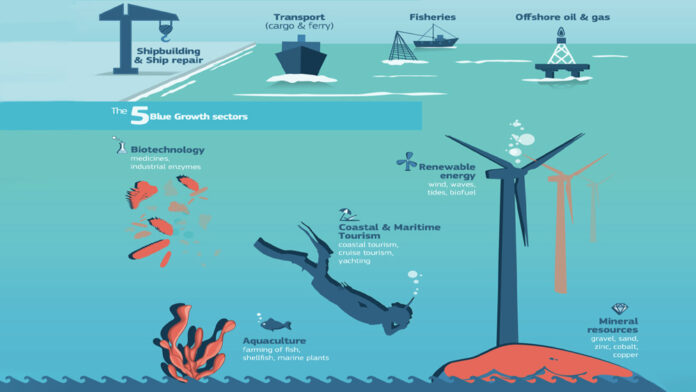In an era where the conservation of our planet’s resources has taken center stage, the term “Blue Economy” has emerged as a beacon of hope and sustainable development. The Blue Economy encapsulates a holistic approach to utilizing the ocean’s resources while safeguarding its delicate ecosystems. This comprehensive guide aims to unravel the intricacies of the Blue Economy, exploring its significance, potential, challenges, and the path it paves toward a more prosperous and sustainable future.

Contents
Understanding the Blue Economy
The Blue Economy, in essence, encompasses all economic activities that directly or indirectly involve the oceans, seas, coasts, and marine resources. This concept extends far beyond traditional industries like fisheries and shipping, encompassing a wide spectrum of sectors such as renewable energy, tourism, biotechnology, aquaculture, marine research, and more. Unlike the exploitative practices of the past, the Blue Economy emphasizes responsible and balanced utilization to ensure the longevity of marine resources for generations to come.
Significance and Potential
The oceans cover more than 70% of the Earth’s surface and play an indispensable role in regulating climate, providing sustenance, and fostering biodiversity. The Blue Economy capitalizes on the incredible potential of these vast marine ecosystems while prioritizing conservation and sustainable growth. Here’s a glimpse of its significance:
1. Economic Growth
The Blue Economy has the potential to drive substantial economic growth by tapping into the plethora of resources the oceans offer. Industries such as offshore wind energy, marine biotechnology, and deep-sea mining promise new avenues for revenue generation and job creation.
2. Sustainable Livelihoods
For many coastal communities, the oceans are a lifeline, providing employment, food, and cultural identity. By harnessing the Blue Economy, these communities can thrive while safeguarding their environment and cultural heritage.
3. Innovation and Research
The oceans are a treasure trove of untapped potential, housing diverse ecosystems and countless species that hold secrets yet to be unveiled. Marine research and biotechnology can lead to groundbreaking discoveries, from new medical treatments to sustainable materials.
4. Climate Regulation
Oceans act as carbon sinks and play a pivotal role in regulating global climate patterns. Sustainable practices within the Blue Economy can help mitigate climate change by preserving these vital functions.
5. Conservation and Biodiversity
The Blue Economy places a strong emphasis on conservation, ensuring that marine ecosystems remain intact and thriving. By adopting sustainable practices, we can protect vulnerable species and habitats from irreversible damage.
Challenges and Roadblocks
While the Blue Economy holds immense promise, it is not without its challenges. Ensuring that economic activities do not harm the environment and that coastal communities benefit requires a delicate balance. Some key challenges include:
1. Overexploitation and Pollution
Unregulated fishing, plastic pollution, and habitat destruction pose grave threats to marine ecosystems. Striking a balance between resource utilization and conservation is imperative.
2. Lack of Regulation
The global nature of the oceans makes regulation and enforcement complex. Collaborative efforts are needed to establish guidelines and standards for responsible ocean use.
3. Technological Limitations
Many industries within the Blue Economy are still in their infancy, requiring substantial research and development to reach their full potential.
4. Economic Inequities
Ensuring that benefits are distributed fairly among coastal communities, especially in developing nations, is crucial to prevent exacerbating economic disparities.
A Vision for the Future
The Blue Economy represents a visionary approach to sustainable development, intertwining economic growth with environmental stewardship. To fully realize its potential, global cooperation is essential. Governments, industries, researchers, and communities must come together to:
- Develop and implement robust regulatory frameworks to prevent overexploitation and pollution.
- Invest in research and innovation to unlock the full potential of marine resources.
- Foster education and awareness about the importance of the oceans and the need for sustainable practices.
- Support coastal communities by creating opportunities for economic growth while preserving cultural heritage and livelihoods.
- Collaborate on international platforms to address challenges that transcend borders, such as climate change and illegal fishing.
Conclusion
The Blue Economy offers a roadmap to prosperity that transcends short-term gains and emphasizes the preservation of our planet’s most precious resource: the oceans. By navigating the complex waters of sustainability, responsible utilization, and equitable distribution of benefits, we can ensure that the Blue Economy remains a beacon of hope for a brighter, more harmonious future. Through collective efforts, we can embark on a journey toward sustainable development that leaves a legacy of abundance for generations to come.
